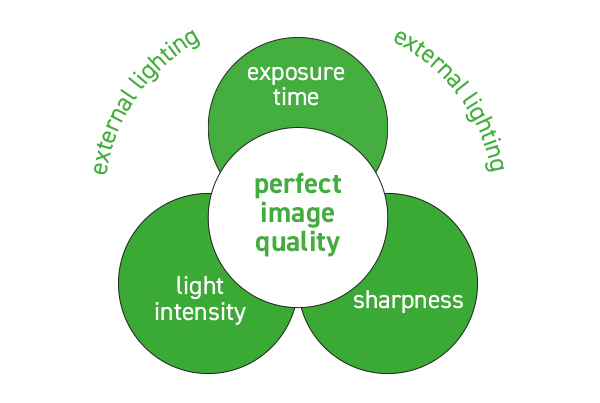
In the realm of precision machine vision systems, there’s no room for chance. The quality of captured images—and consequently, the effectiveness of inspection, quality control, and automation processes—hinges on a meticulously balanced interplay of key parameters: ambient light, exposure time, and illuminator intensity. Yet, one often underestimated factor plays a pivotal role: sharpness. It’s frequently the determining element in the success or failure of accurate image analysis.
This article delves into how these factors interrelate, their impact on the efficiency of vision systems, and how leveraging advanced features like overdrive mode and fast rise/fall time control in modern illuminators can elevate imaging quality to unprecedented levels.
Ambient Light: The Invisible Variable in Vision Systems
Ambient light is a variable that’s often challenging to eliminate entirely. Natural daylight, reflections from surfaces, or unpredictable lighting changes in production facilities can significantly affect image quality.
Even minor fluctuations in ambient brightness can lead to contrast variations, edge detection issues, or erroneous barcode and defect readings. Therefore, it’s crucial to:
✅ mitigate ambient light influence by employing shields, vision enclosures, or optical filters.
✅ enhance the dominance of controlled light sources to ensure the illuminator’s output supersedes environmental interferences
Practical Tip: Even in well-controlled industrial settings, incorporating ambient light considerations into system calibration procedures is advisable.
Exposure Time: Balancing Brightness and Dynamics
Exposure time refers to the duration the camera sensor collects light. Too short, and the image may be underexposed; too long, and there’s a risk of motion blur with moving objects.
Short exposure times necessitate more intense illumination to compensate for reduced light collection. This is particularly critical in high-speed production lines, where every millisecond counts.
Advanced lighting solutions equipped with overdrive mode allow for brief, high-intensity light pulses without overheating the source. This capability enables the capture of sharp, well-lit images even at very short exposure times.
Note: Utilizing overdrive in conjunction with short exposure times helps minimize the effects of vibrations and motion, enhancing image sharpness and contrast.
Sharpness: The Key to Detail Clarity
In machine vision, sharpness isn’t solely about lens focus. It’s also the result of the synergy between exposure time, lighting, and the overall system’s stability.
• Insufficient lighting may require longer exposure times, increasing the risk of motion blur.
• Excessive lighting can cause overexposure, leading to loss of subtle details and perceived sharpness.
Achieving high-quality sharpness also demands precise depth-of-field settings and minimizing system vibrations. Implementing LED illuminators with fast rise/fall time control facilitates precise synchronization of light pulses with the camera, reducing blur and enhancing inspection repeatability
Tip: Regularly calibrating focus using standard inspection objects improves detection consistency and precision.
Illuminator Intensity: The Heart of Vision Systems
The illuminator is the cornerstone of any vision application, dictating contrast levels, edge quality, and image depth.
Advanced illuminators offer more than just standard intensity adjustments; they provide:
✅ Overdrive mode for short, intense light pulses.
✅ Fast rise/fall time control for precise synchronization with camera operations
✅ Dynamic intensity control, allowing real-time adaptation to changing operational conditions.
These features not only tailor the system to specific application needs but also enhance its flexibility and reliability in fluctuating production environments.
Conclusion: The Path to Perfect Imaging
Professional vision systems require a precise orchestration of light, timing, and sharpness. Mastering these parameters leads to superior image quality, more effective inspections, and improved process reliability.
With advanced functionalities in modern illuminators, such as overdrive mode and fast rise/fall time control, systems can be finely tuned to meet specific requirements and significantly broaden their capabilities.
At ISCON, we’ve been assisting clients for years in designing and implementing vision systems, providing top-tier LED illuminators and expert knowledge. Our solutions ensure each inspection is more precise, and production processes become more reliable and consistent.
Investing in quality illumination is investing in the clarity of your quality.
Want to learn more about the new IBRPX model and its capabilities?
Contact us:
